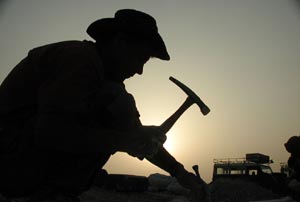Dinosaur Expedition 2000 allows us to join team in Niger
By Steve KoppesNews Office
 Follow the fossils: Paul Sereno and his team of paleontologists are unearthing more dinosaur finds in Niger. |
“The areas we’re going into are not only interesting, they’re brand new,” said Sereno before he left for Africa in August. “These places have never been explored at all before. We’re very excited about it.”
Sereno led successful dinosaur-hunting expeditions to Africa in 1993, 1995 and 1997.
The 2000 expedition is sponsored by the National Geographic Society and the David and Lucille Packard Foundation.
The “Dinosaur Expedition 2000” online expedition is sponsored by Project Exploration with support from the National Geographic Education Foundation, the John and Margaret Hettwer Foundation and the Illinois State Board of Education. Co-founded by Sereno and his wife, educator Gabrielle Lyon, Project Exploration is a not-for-profit science education organization dedicated to making paleontology and natural science accessible to children living in urban areas.
It normally takes months or years for the details of Sereno’s expeditions to become widely known, but Project Exploration is changing that.
“Dinosaur Expedition 2000 will let people witness cutting-edge science in the making and learn about dinosaur discoveries as they happen,” Lyon said last August. “We’ll also be corresponding online and via regular mail with students in more than 30 classrooms around Illinois. It’s a unique way to make science accessible and connect kids with real-life science,” added Lyon, vice president of Project Exploration and a veteran expedition member.
Sereno’s 14-person team is crisscrossing northern Niger, exploring dinosaur beds ranging in age from 90 million to 135 million years old. The team members first stopped in an area with 110-million-year-old sediments, where they filled out the skeleton of Nigersaurus, a bizarre long-necked, plant-eating dinosaur Sereno discovered during the 1997 expedition to Niger.
“Nigersaurus is one of the strangest dinosaurs ever found because of the unusual shape of its jaw and the great number of teeth it had,” Sereno said. “The animal had about 600 teeth packed into its jaws.”
Now the expedition members are visiting the area where, in 1997, Sereno excavated skeletons of the long-necked Jobaria, an ancient lineage that survived and flourished only in Africa. Jobaria was the centerpiece of the “Dinosaur Giants” exhibition at Chicago’s Navy Pier last spring.
One of the team’s last stops will be in the 90-million-year-old beds of remote northern Niger that correspond to a layer where, in 1995, Sereno’s team uncovered Deltadromeus, a new 30-foot long predator, and the first skull of the Tyrannosaurus-sized meat-eater, Carcharodontosaurus.
Sereno’s expedition will mark the return of three dinosaur discoveries to Niger, where they will go on display at the National Museum in Niamey, the capital city. The team will return to Niger the original fossils of Afrovenator, a 27-foot-long predator discovered during Sereno’s 1993 expedition, along with cast skeletons of Suchomimus and Jobaria.
Suchomimus, an enormous predatory dinosaur with a skull similar to a crocodile’s, was discovered in 1997.
The only other skeleton of Suchomimus is on display at the Chicago Children’s Museum on Navy Pier.
Sereno has five paleontology students and alumni assisting him in Niger. Those previous and current students are David Blackburn, a fourth-year under graduate from Chicago; Allison Beck, a graduate student from Memphis, Tenn.; Jack Conrad, a graduate student from Hurley, Mo.; Hans Larsson, who recently completed a doctorate, from rural Cobourg, Ontario, Canada; and Christian Sidor, who also completed a doctorate, from West Hartford,Conn.
![[Chronicle]](/images/small-header.gif)